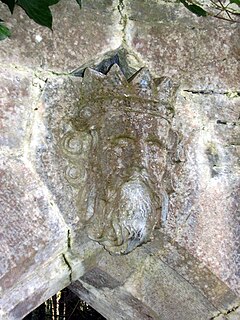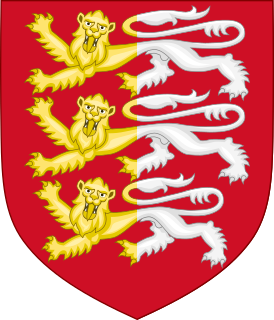| |||||
| Centuries: | |||||
|---|---|---|---|---|---|
| Decades: | |||||
| See also: | Other events of 1153 List of years in Ireland | ||||
Events from the year 1153 in Ireland.
| |||||
| Centuries: | |||||
|---|---|---|---|---|---|
| Decades: | |||||
| See also: | Other events of 1153 List of years in Ireland | ||||
Events from the year 1153 in Ireland.
| | This Ireland-related article is a stub. You can help Wikipedia by expanding it. |
Diarmait Mac Murchada, anglicised as Dermot MacMurrough, Dermod MacMurrough, or Dermot MacMorrogh, was a King of Leinster in Ireland. In 1167, he was deposed by the high king of Ireland – Ruaidri Ua Conchobair. The grounds for the deposition were that Mac Murchada had, in 1152, abducted Derbforgaill, the wife of the king of Breifne, Tiernan O'Rourke. To recover his kingdom, Mac Murchada solicited help from King Henry II of England. His issue unresolved, he gained the military support of the Earl of Pembroke. At that time, Strongbow was in opposition to Henry II due to his support for Stephen, King of England against Henry's mother in The Anarchy. In exchange for his aid, Strongbow was promised in marriage to Mac Murchada's daughter Aoife with the right to succeed to the Kingship of Leinster. Henry II then mounted a larger second invasion in 1171 to ensure his control over Strongbow, resulting in the Norman Lordship of Ireland. Mac Murchada was later known as Diarmait na nGall. He was seen in Irish history as the king that invited the first ever wave of English settlers, who were planted by the Norman conquest. Another outcome of the invasion was for the very first time the indigenous Celtic Christian Church in Ireland would come under the jurisdiction of the Holy See through a bull issued to the Normans by the then Pope Adrian IV.

Ruaidrí mac Tairrdelbach Ua Conchobair was King of Connacht from 1156 to 1186, and High King of Ireland from 1166 to 1198. He was the last High King of Ireland before the Anglo-Normans invaded Ireland.

St. Lorcán Ua Tuathail, known in English as Saint Laurence O'Toole and in French as St. Laurent d'Eu, was Archbishop of Dublin at the time of the Norman invasion of Ireland. St. Lorcán played a prominent role in the Irish Church Reform Movement of the 12th century and mediated between the parties during and after the invasion. He was canonised in 1225 by Pope Honorius III.

West Connacht was a kingdom of Gaelic Ireland, associated geographically with present-day County Galway, particularly the area known more commonly today as Connemara. The kingdom represented the core homeland of the Connachta's Uí Briúin Seóla kindred and although they ruled, there were smaller groups of other Gaels in the area, such as the Delbhna Tir Dha Locha and the Conmhaícne Mara. It existed from 1051 onwards, after the Ó Conchobhair, Kings of Connacht, pushed the Ó Flaithbheartaigh to the West of Lough Corrib, from their original territory of Maigh Seóla. Iar Connacht remained a subordinate túath of Connacht, until the 13th century, after which it was more independent.

O'Flaherty, is an Irish Gaelic clan based most prominently in what is today County Galway. The clan name originated in the 10th century as a derivative of its founder Flaithbheartach mac Eimhin. They descend in the paternal line from the Connachta's Uí Briúin Seóla. They were originally kings of Maigh Seóla and Muintir Murchada and as members of the Uí Briúin were kinsmen of the Ó Conchubhair and Mac Diarmada amongst others. After their king Cathal mac Tigernán lost out to Áed in Gai Bernaig in the 11th century, the family were pushed further west to Iar Connacht, a territory associated with Connemara today. They continued to rule this land until the 16th century.
Conchobar Maenmaige Ua Conchobair, son of High King of Ireland Ruaidrí Ua Conchobair, was King of Connacht from 1183 to 1189. He was a military commander and opponent of the Norman invasion of Ireland.

Dunmore is a village in County Galway, Ireland. It is located on the N83 national secondary road at its junction with the R328 and R360 regional roads.
Events from the year 1156 in Ireland.
Events from the year 1166 in Ireland.
Events from the year 1224 in Ireland.
Events from the year 1202 in Ireland.

Aodh, , ; is an Irish and Scottish Gaelic male given name, originally meaning "fire". Feminine forms of the name include Aodhnait and Aodhamair. It appears in even more variants as a surname. As a surname, the root or a variant may be prefixed by O, Ó, or Ui, Mac or Mc, or Nic.
Mór Ní Thuathail was a Queen-consort of Leinster as the principal first wife of King Diarmait Mac Murchada. Under Brehon Law, Irish men were allowed more than one wife. King Dermot's second wife was Sadhbh Ní Fhaolain.
Murrough Ua Cellaigh was the 41st King of Uí Maine and 8th Chief of the Name.
Maghnus Ua Conchobair, Prince of Connacht, died 1181.
Diarmait mac Énna meic Murchada was an early twelfth-century ruler of the kingdoms of Leinster and Dublin.
Events from the year 1115 in Ireland.

The O'Brien dynasty is a royal and noble house founded in the 10th century by Brian Boru of the Dál gCais or Dalcassians. After becoming King of Munster, through conquest he established himself as Ard Rí na hÉireann. Brian's descendants thus carried the name Ó Briain, continuing to rule the Kingdom of Munster until the 12th century where their territory had shrunk to the Kingdom of Thomond which they would hold for just under five centuries.
Events from the year 1124 in Ireland.
Feilim is an Irish language name for men, which means "beauty, ever good, constant." The name is derived from the older version Feidlimid, it has been anglicised as Phelim, Feilmy or even Felix.